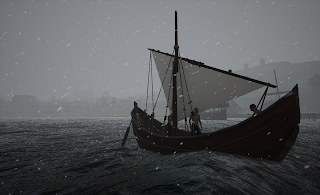Yenikapi: Port of Scarborough 1264
I had a couple of spare minutes today between film shooting, so turned to modelling some of the other boats that might have been seen off shore. The film plot calls for a couple of different merchant groups - including a group of boats bringing exotic goods from the newly restored Byzantine empire.
The high prow'd Yenikapi, was a coastal trading ship of the 9th Century AD Byzantine Empire. In 2007, it was discovered in the Theodosius Harbor off the Golden City, Istanbul (Constantinople). At only 9 meters in length, it is smaller than the other trading ships built so far for the Scarborough set (knarr, cogs and a herring boat) - but its distinctive shape (and the craftsmanship exhibited in the boat construction) attest the skill of early/high medieval ship builders. It is possible that small vessels of this type were ubiquitous in coastal trade throughout Europe. The boat found in 2007 was capable of carrying a load of 250 amphoras - but... this is what I would call a wet boat.
The Istanbul Koç Museum has constructed a replica of the boat and a detailed description of the craft has been published by Işıl Özsait-Kocabaş. From these sources, within Unreal Engine, i was able to throw together a 3D model in about 30 minutes. On my first attempt I use brute force - PathExt (poly path exude) built a shape frame and internal ribs. I then used PolyEd to build one side of the clinker hull, PlaneCutting to tidy the loose ends before Mirroring the rest of the hull. With a little more time, a second effort proceeded by warping a plane to the shape of the hull.
While the sail still needs to be converted into a cloth subject to wind inside the Engine, Botulf's crew (who figure in the first episode) are taking her for a try out in heavy weather. Botulf is one of a couple of captains of the trader Strategopoulos.
Here is the brute force effort.
And here is the more conventional plane shaping form on the 1254 set, with the old pier near the Damyot. To the back left is a Knarr, and center back is the port reeve's custom boat. We imagine the old pier here to have partially collapsed by 1264 as all efforts were being directed to building an all weather port to the far right.
The scene takes on a different feel with wind and the conversion of sail to cloth physics.
As noted above, this model was made for background shots - in full light on the ocean, a close up cannot hide the clunky look of the first model. This type of asset could be coated with a voxel layer to create a more complex surface - but, now we have the second form, that is unnecessary.













Comments